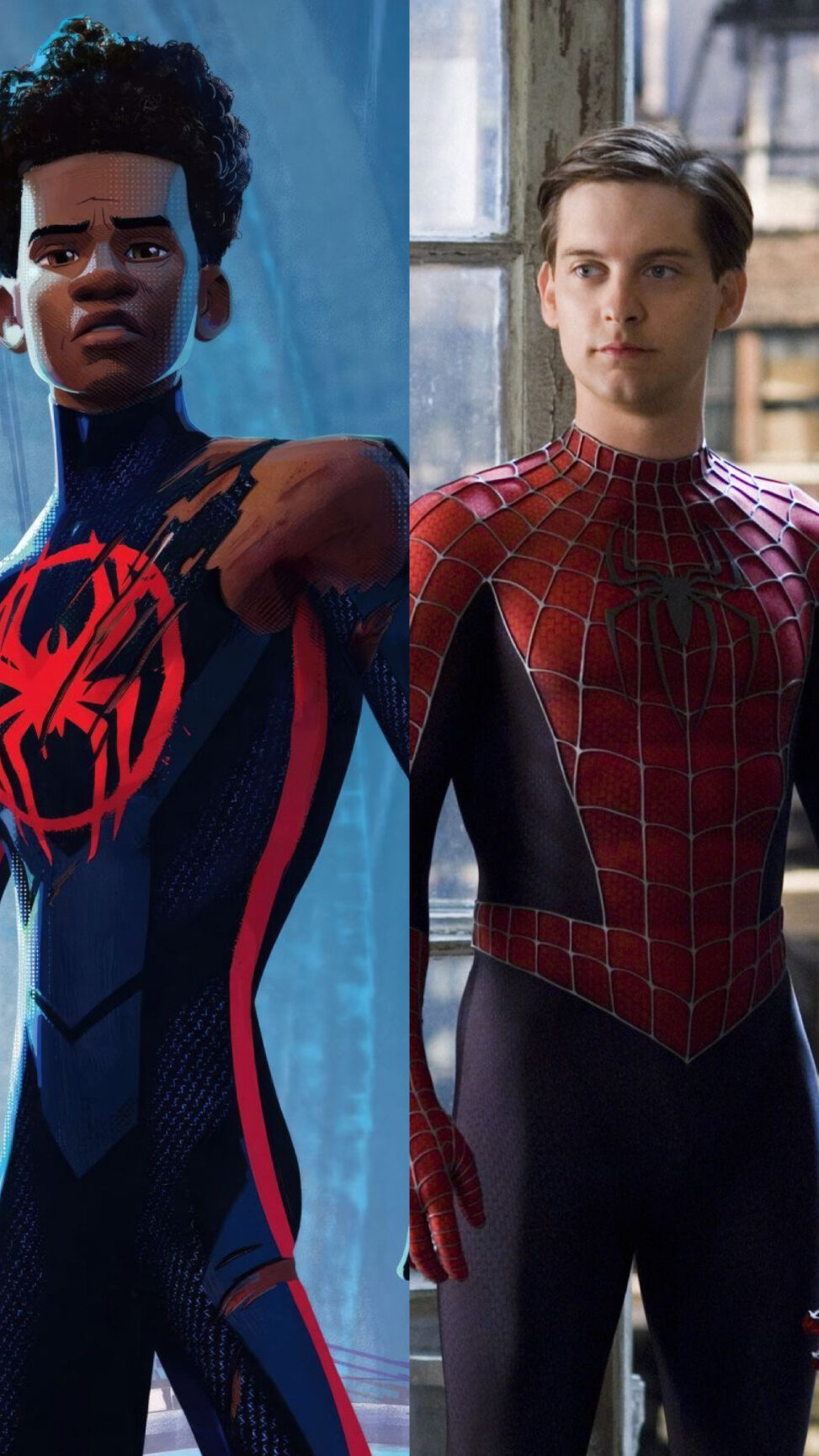Miles Morales as Spider-Man
Throughout the development of Marvel’s Spider-Man, we have seen three actors recreate and develop the character of Peter Parker. On paper Peter Parker is a high school student who is bitten by a radioactive spider and as a result gains supernatural spider-like ability. In all the live-action adaptations the story varies with its actors and love interests. In all the live-action adaptations, Spider-Man is a white, male, brunette high schooler despite the change of actors. This was until 2018, when Marvel released an animated Spider-Man movie where Spider-Man is a Black-Latino high schooler, he is slightly younger than the other Spider-Men. Spider-Man was one of the first teenage superheroes, and these movies not only inspired a plethora of viewers who fit the white, male classification but also a variety of other genders and races due to the new animated movie.
Before 2018 we did not see any other adaptations of Spider-Man outside of the white, male stereotype. This is due to the lack of representation of minorities in media at all. When the animated movie Into the Spider-Verse came out, they played with the idea that “anyone could wear the mask.” They did this through the theory of a multiverse where, depending on the universe, the Spider-Man was a different race, ethnicity, gender, and age. This allowed for Marvel to move away from the monotonous idea of the character of Spider-Man being a straight, white male in every universe. Unlike the three Spider-Men before him, he was given his own unique story line that embodied not only the struggles of being a superhero but also the struggles of being a Black teenager. “According to Moseley, Spider-Man’s class position, non-traditional family, and the media’s unfavourable portrayal of his heroics resonate more closely with urban Black experiences than the experiences of a white boy from Queens.” (Mills 2022, 1) This opened doors for them to play with the idea of anyone being able to be Spider-Man no matter what traits they possessed. Those who didn’t fit the stereotype of the original Spider-Man showered this film with overwhelmingly positive feedback about the importance of representation and diversity. This is a metaphor that despite your demographic characteristics, you can do or be whatever you set your mind to.
Earlier in that same year, they released the live-action Black Panther, another film that focused mainly on Black characters. These two films being released in the same year helped viewers, more specifically Black viewers, realize how good it felt to see people who look like them in mainstream media, let alone the illustrious Marvel Comics. Their push for diversity inspired other companies, such as Disney, to create projects that centre around underrepresented communities. After 2018, movies such as Encanto (2021) and Turning Red (2022) were created that accurately depicted different cultures. This caused a precedent for many other studios to do the same, whether for financial gain or the importance of diversity itself. The popularity of Into the Spider-Verse (2018) also allowed for them to move away from gender norms within their own brand with the release of Ms. Marvel (2022), depicting a teenage, female superhero based on one that already existed within a different demographic of people. The act of moving away from one stereotypical depiction of a character, no matter the category (e.g., race, gender, age, or ethnicity), will in turn allow more freedom for changes of other huge traits of a character. The idea of diversity in media will change viewer expectations on diversity and its growing commonplace in films. This is inherently a good thing due to the confidence and belonging representation anywhere makes people feel, especially those who are underrepresented.
There will always be prejudice against films that change the original depiction of a character. This is usually due to underlying racist or misogynistic ideals. Most people who are part of very represented categorizations feel that it’s unnecessary to change pre-existing characters’ attributes. Many of the one-star reviews are calling this switch in race unnecessary; one viewer deems it “woke shit.” Movies such as this will always receive backlash for their diversity, but despite these uneducated reviews, the film was met with overwhelming positivity. “A letter from a “young Hispanic male” celebrating Miles’s introduction is immediately followed by a riposte from a self-described “valued reader”; the latter is “disappointed and offended” that Marvel would replace Ultimate Peter Parker—the main continuity version of the character remained very much alive—with an African American/Hispanic person… for the sole reason of diversity.” (Jeffries 2022/2023, 198) Sometimes those who are not faced with a lack of representation of their community will not understand why diversity is important. Despite this, diversity has found a new commonplace within film and is now an expectation rather than an obscurity. Further in the future if diversity continues to become commonplace in film and media these depictions of minority characters will become normalized to the point that it is no longer an issue.
—————————————————————————————————————-
Bibliography
Jeffries, Dru. “‘Anyone Can Wear the Mask’: The Marginalization of Miles Morales in Spider-Man: Into the Spider-Verse.” JCMS: Journal of Cinema & Media Studies 62, no. 5 (August 1, 2023): 192–214. doi:10.1353/cj.2022.a907197.
Marie Mills, Regina. “A Post-Soul Spider-Man: The Remixed Heroics of Miles Morales.” Black Scholar 52, no. 1 (January 1, 2022): 41–52. doi:10.1080/00064246.2022.2007345.
Mullins, Dagbovie, and Eric L. Berlatsky. “Mixed-Race Superheroes.” Google Books, 2021. https://books.google.ca/books.
Worlds, Mario, and Henry “Cody” Miller. “Miles Morales: Spider-Man and Reimagining the Canon for Racial Justice.” English Journal 108, no. 4 (March 1, 2019): 43–50. https://doi.org/10.58680/ej201930049.


Rawle Fletcher
This student does a really good job showing how Spider-Man has changed over time and how Miles Morales brings something totally new to the story. They clearly explain that Peter Parker represents the classic, white, middle-class version of the hero, while Miles is a younger Black-Latino kid whose story reflects a more diverse and realistic version of today’s world. The comparison between the two Spider-Men is strong, especially when the essay connects Miles’s story to bigger ideas about representation in film.
Their main point is that Into the Spider-Verse (2018) broke away from the “white male hero” stereotype and opened up space for more people to see themselves as heroes. The student connects this change to movies like Black Panther, Encanto, and Turning Red, showing how diversity has become more normal in Hollywood. This gives their argument a lot of depth because it links Miles’s story to real cultural change rather than just focusing on the character.
The essay uses solid scholarly sources like Jeffries, Mills, and Mullins & Berlatsky, which makes the argument feel well researched. Still, it could have gone a bit further by directly comparing Miles and Peter’s personalities or how their struggles are different beyond race. For example, a closer look at how each one deals with responsibility or identity would have made the analysis even stronger.
The two images, the animated Miles and Tobey Maguire’s live-action Peter, work well to show how different they are visually and symbolically. Overall, the essay is clear, relevant, and thoughtful, and it succeeds in showing how Spider-Man: Into the Spider-Verse helped redefine what a superhero can look like today.